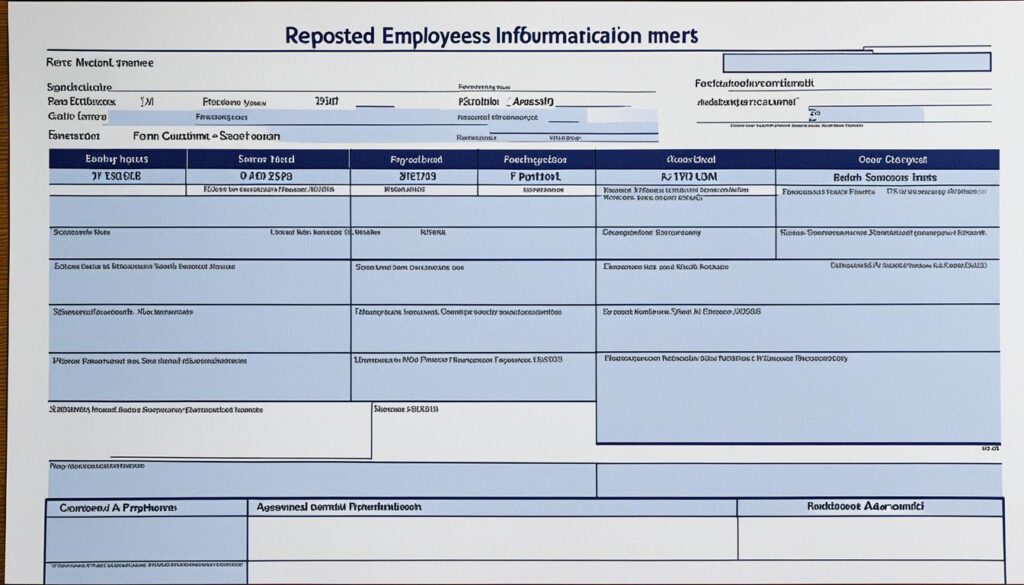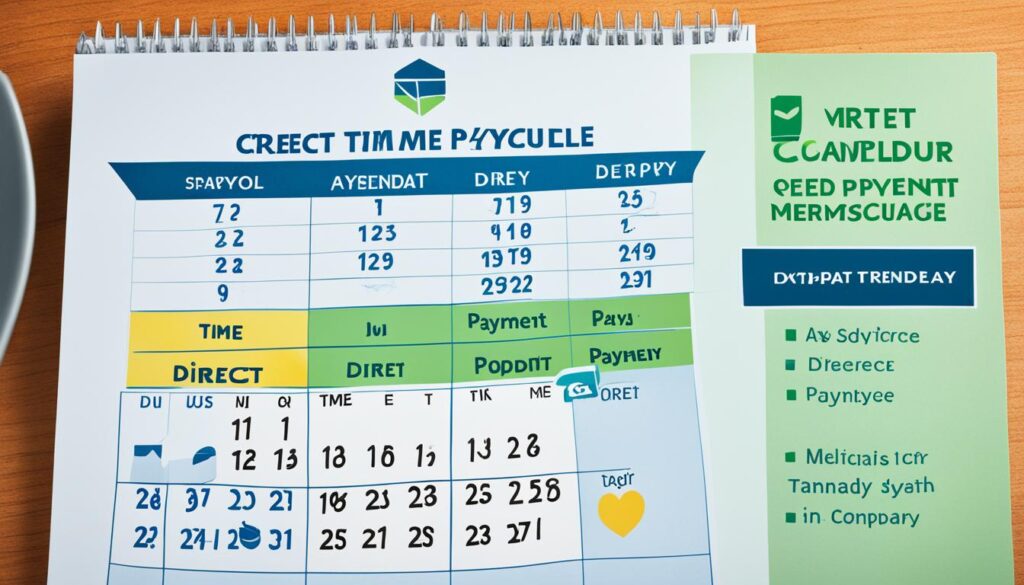Direct deposit for employees is a crucial part of managing payroll. It offers both convenience and security. This ensures workers get their pay on time. Additionally, it makes the payroll process smoother without the use of paper checks.
This guide will walk you through setting up direct deposit for your team. It will simplify your payroll system, making life easier for everyone.
Key Takeaways:
- Direct deposit ensures timely payment and provides convenience for employees.
- It eliminates the need for paper checks, reducing administrative tasks.
- Setting up direct deposit can be done by following simple step-by-step instructions.
- Choosing a reliable direct deposit provider is important for a smooth experience.
- Enter employee data accurately and establish a direct deposit payroll schedule.
What Is Direct Deposit?
Direct deposit is a modern and safe way to get paid. It sends wages straight from your boss’s bank to yours. This means no more trips to the bank to cash paychecks.
This system can put money into your checking, savings, or even a special payroll card. It makes getting paid easy and cuts out the hassle of paper checks.
It’s not just easy, it’s also safe. Lost or stolen checks are no longer a worry with direct deposit. Your money goes right to your account, protecting your earnings.
Direct deposit is loved by both workers and bosses. It makes life simpler without sacrificing security.
Benefits of Direct Deposit
- Convenience: Employees can easily access their wages without the need to deposit physical checks or visit the bank.
- Security: Direct deposit eliminates the risk of lost or stolen checks and provides a secure transfer of funds.
- Efficiency: The automated nature of direct deposit streamlines the payment process, saving time and reducing administrative tasks.
- Reliability: With direct deposit, employees can rely on consistent and timely wage deposits.
- Cost Savings: Direct deposit reduces the need for paper checks and manual deposit processes, resulting in cost savings for employers.
Direct Deposit vs. Traditional Payment Methods
Direct deposit is way better than using paper checks. It saves companies money and time. Workers don’t need to spend time at the bank either.
It also keeps digital records of your payment. This helps with taxes and audits, making life easier for everyone.
In short, direct deposit is a win for everyone. It’s easy, safe, and streamlines how we get paid. Businesses and their teams both benefit from using it.
| Direct Deposit Benefits | Traditional Payment Methods |
|---|---|
| Convenience | Requires manual deposit of paper checks |
| Security | Risk of lost or stolen checks |
| Efficiency | Time-consuming distribution and reconciliation of paper checks |
| Reliability | Potential delays or issues with check delivery |
| Cost Savings | Printing, distributing, and reconciling paper checks |
How Does Direct Deposit Work?
Direct deposit makes paying employees simple through electronic transfers. Here’s how it all happens:
1. Employer initiates the transfer: The boss sends payroll details to their bank. They give permission to send money from the company’s account to the employee’s chosen account.
2. Bank contacts the employee’s financial institution: Next, the employer’s bank talks to the employee’s bank. They start the deposit process. This makes sure the money goes where it should easily.
3. Employee’s bank processes the deposit: The employee’s bank gets the money and puts it in the employee’s bank account. The amount is now ready for the employee to use.
It usually takes just two to three days for someone to get their money with direct deposit. This way is quicker and safer than using paper checks. It also lowers the risk of check loss or theft.
Increased Efficiency and Security
Direct deposit improves how companies pay their employees. It’s good for everyone, giving many advantages:
- Efficiency: Say goodbye to writing checks by hand. This saves a lot of time and work.
- Security: It lessens the chance of paychecks getting lost or stolen. Money goes right into the bank account safely and on time.
By using direct deposit, businesses can make paying workers more efficient and secure. Employees enjoy quick and safe electronic payments.
How Much Does It Cost To Set Up Direct Deposit for Employees?
The price to set up direct deposit varies. It depends on your bank’s software and the bank you choose. Some banks might have a setup fee or charge monthly. They might also ask for a minimum balance or a fee for each transaction.
Before you choose, look at the fees of different direct deposit options. Think about how big your team is, how often you pay them, and what your business needs. Setting up direct deposit has costs, but it makes payroll easier.
“Direct deposit makes paying employees easier, saving time and reducing the chance of checks being lost or stolen.”
With direct deposit, your payroll gets more efficient and accurate. This means you save time and money on paper checks. A smoother process also lowers the chance of mistakes compared to doing payroll by hand.
Setting up direct deposit might cost you. But, the time and resources it saves in the long run are worth it. It’s good for big and small businesses alike, offering better payroll, more efficiency, and secure payments.
Direct Deposit Cost Comparison
| Financial Institution | Setup Fee | Monthly Fee | Transaction Fee | Minimum Balance Requirement |
|---|---|---|---|---|
| Bank A | No setup fee | $10 | $0.50 per deposit | $500 |
| Bank B | $50 | $5 | No transaction fee | No minimum balance |
| Bank C | $25 | No monthly fee | $1 per deposit | $1,000 |
The table compares costs from three financial institutions. It’s key to look closely at the fees when picking a provider. Think about what your business needs and can afford. This will help you find the right fit for your direct deposit service.
Don’t just consider the cost. Look at what each provider offers too. A well-known direct deposit service can make your payroll process smoother. It brings efficiency and convenience to your business.
Step 1: Choose a Direct Deposit Provider
The first big decision in setting up direct deposit for your workers is picking the right provider. It’s important to choose a provider known for its security and reliability. This ensures your employees will get their pay without any issues.
Before you pick, look at what other customers have said. Hearing about their experiences can help you decide. This will help you find a provider that meets your company’s needs and delivers great service.
Choosing a payroll service that includes direct deposit features can make things even easier. These services are designed to smoothly handle direct deposits. So, managing and keeping track of payments becomes simpler.

Choosing a reputable direct deposit provider is essential for a smooth and reliable direct deposit experience.
Step 2: Complete the Direct Deposit Setup Process
After selecting a direct deposit provider, the next step is setup. You’ll need to sign ACH terms and conditions and hand in financial statements. Then, add your business info to the system.
To get direct deposit ready, you must first sign the ACH terms. These rules make sure direct deposit follows banking laws. This step is very important.
You’ll also have to show some financial documents to prove your business is strong and stable. The bank or provider might ask for your balance sheet, income statement, and cash flow data. They use this info to see if you can use direct deposit.
After you submit the needed paperwork, it’s time to input your business details. Things like your company’s name, address, and bank account are needed. Make sure everything you enter is correct. This will help the setup go smoothly.
Benefits of Completing the Direct Deposit Setup Process
Setting up direct deposit has great perks for everyone involved:
- Convenience: Direct deposit makes payroll easier minus the manual work.
- Efficiency: It makes paying employees faster, saving time and money.
- Security: It ensures that money moves safely and privately.
- Timely Payments: Employees get their pay on time, anywhere and anytime.
By finishing direct deposit setup, you make payroll better for your business and your workers.
| Key Steps for Direct Deposit Setup | Benefits |
|---|---|
| Review and sign ACH terms and conditions | Ensures compliance and secure transactions |
| Provide financial statements | Establishes credibility and eligibility |
| Enter business details into payroll software or banking system | Facilitates seamless direct deposit transactions |
Step 3: Gather Information From Employees
After completing the initial steps, gathering employee information is key for direct deposit setup. You’ll need their name, date of birth, address, Social Security Number or Tax ID, bank name, routing number, and account number. It’s vital to have the correct and current info for a trouble-free process.
Give employees a direct deposit form to fill out. This form helps collect all needed bank details and their approval. It ensures the safety of their personal data and helps you set up direct deposit easily.

Quote: “Direct Deposit forms simplify the process of gathering employee information and provide a standardized format for collecting banking details.” – John Smith, Payroll Manager
The direct deposit form must be simple and clear. It should clearly show what information is needed, like personal and banking details. The form also includes a part for employees to agree to direct deposit. This step ensures everyone follows the rules and protects all involved.
Providing a direct deposit form to employees makes things smoother. It ensures correct information is given and keeps your records neat. Plus, it provides a standard way to collect necessary details.
| Required Employee Information | |
|---|---|
| Name | |
| Date of Birth | |
| Mailing Address | |
| Social Security Number or Tax ID Number | |
| Financial Institution Name | |
| Routing Number | |
| Account Number |
Thorough and complete employee information collection is crucial for an easy direct deposit setup. This step is essential for building a reliable and smooth payroll system for both sides.
Step 4: Enter Employee Data Into Your System
Now, it’s time to put the employee data into your system. This makes sure that your payroll records are right. You can enter data by hand or all at once.
Manual Entry
Filling in each employee’s details by hand is manual entry. You type in names, addresses, birth dates, and SSN or Tax ID. Bank info like the name, routing number, and account number goes in too.
Doing this lets you check each data point one by one. It stops a lot of mistakes. This way is great if you do things yourself and have only a few employees.
Bulk Upload
For a bigger team or if you want to be quick, bulk upload is handy. You usually do this with a NACHA file. NACHA files hold lots of employee info, both personal and bank.
A NACHA file lets you add many employees to your system at once. This saves a lot of time. It’s perfect for lots of changes or if you often add new employees.
To get help with NACHA files or other bulk ways, look in the help guides from your system. Or, you can ask your payroll company for support.
Don’t forget to update your data when things change. This could be for new bank details or if someone moves. Keeping things current helps your payroll stay right.
| Manual Entry | Bulk Upload |
|---|---|
| Allows for careful review of each employee’s data | Time-saving option for large workforces |
| Suitable for small employee numbers and full control over data entry | Reduces the likelihood of manual entry errors |
| Convenient for high turnover rates and frequent updates |
Step 5: Establish a Direct Deposit Payroll Schedule
Setting up direct deposit for your employees is very important. It makes sure they get paid on time and without problems. You should match the payment dates with your company’s schedule and any holidays the bank has. This approach makes the whole process smoother and cuts down on late payments.
It’s vital to talk clearly with your team about how direct deposits will work. Be sure to tell them exactly when they’ll get their money in their accounts. This lets them manage their money better and stops any worry about when they’ll be paid.
Be sure you also give your employees access to digital payment records. This lets them check their deposits and keep digital copies for their records or taxes.
Effective communication and providing digital records of direct deposit payments can help foster trust and transparency between employers and employees.
Sample Direct Deposit Schedule
Here is an example of a direct deposit payroll schedule:
| Pay Period | Payday | Direct Deposit Date |
|---|---|---|
| January 1 – January 15 | January 20 | January 22 |
| January 16 – January 31 | February 5 | February 7 |
| February 1 – February 15 | February 20 | February 22 |

Creating a clear direct deposit plan, sharing it with employees, and giving them digital payment records is key. It keeps your payroll running smoothly for everyone involved.
Step 6: Process Payroll
After getting all needed employee info and setting up your payroll schedule, it’s payroll processing time. This ensures your team gets paid right and on time. To make everything run smoothly, here’s what to do:
Gather and Verify Payroll Data
Start by collecting payroll details for this pay period. This means getting hours worked, any extra pay like overtime or bonuses, and other necessary facts. Make sure to double-check everything to catch mistakes early.
Calculate Payroll
Next, use your payroll system to crunch the numbers for each worker. After keying in data, check your work carefully to make sure the math is right.
Submit Payroll to the Bank
Send the payroll details to your bank at least two days before payday. Doing this gives the bank enough time to process the direct deposits. Remember, on-time submissions are key for your team to get paid without delays.
Alternative Payment Options
While direct deposit is the go-to, not everyone can use it. So, be ready with other payment options like paper checks. This way, everyone can get their money the way that works best for them.
To wrap it up, processing payroll means pulling together your data, doing the math, then sending it over to the bank in good time. You should also have alternative payment ways for non-direct deposit users. Following these steps ensures your team’s payment is both accurate and punctual.
Benefits of Setting Up Direct Deposit for Employees
Setting up direct deposit offers many pluses for your payroll process. It ensures payments reach employees on time, makes handling payroll smoother, and is a safe way to pay. Here’s why direct deposit is a good move:
- Timely Payments: Forget about snail mail or long waits at the bank. Direct deposit puts wages right into accounts on payday. This means no late payments and no worries about checks getting lost.
- Efficiency: Say goodbye to manual tasks and the chance of mistakes. Direct deposit makes payroll processing up-to-date and error-free. This shift saves time and effort, letting you concentrate on bigger things.
- Convenience: It’s all about making employees’ lives easier. No bank lines or extra trips needed. Instead, they can use their funds right away. And no lost checks means a lot less stress.
- Security: In today’s world, safety is crucial. Direct deposit keeps personal info protected during transfer. Plus, no physical checks means no check tampering or loss. It’s a win for both sides against fraud.
Clearly, direct deposit does a lot. It boosts payroll flow and keeps everyone happy with their earnings. Because when it comes to paying your team, being on time, secure, and hassle-free is key.

| Benefits of Direct Deposit | Explanation |
|---|---|
| Timely Payments | Direct deposit ensures wages are deposited into employees’ accounts on the designated payday, eliminating delays and disruptions. |
| Efficiency | Automating the payment process with direct deposit saves time and resources, streamlining your payroll system. |
| Convenience | Employees have convenient access to their wages without the need to physically deposit checks at a bank branch. |
| Security | Direct deposit offers enhanced security compared to paper checks, protecting employers and employees from potential fraud. |
Conclusion
Setting up direct deposit for employees is easy and effective. It helps in handling payroll better and makes sure payments are on time. By using the guide provided, you will make your payroll system smoother and more efficient. This method benefits both the company and its workers, offering ease and assurance.
Direct deposit means no more paper checks. This cuts down on mistakes and time spent on manual work. Employees get their pay straight into their bank accounts, which is safe and quick. It makes them happier with their job too.
Choosing direct deposit makes payroll management simpler for businesses. It does away with the trouble of giving out paper checks. Employees get their pay quickly, improving how they plan financially. In summary, direct deposit helps in creating a better, more efficient way to handle payroll.
FAQ
What is direct deposit?
Direct deposit is a way to pay employees. It moves their wages from the company’s bank to their bank. It does this all electronically.
How does direct deposit work?
It works with a simple transfer of money. The employer sends funds to the employee’s account directly.
How much does it cost to set up direct deposit for employees?
Setting up direct deposit may vary in cost. It depends on the bank software and the bank itself.
How do I choose a direct deposit provider?
Look for a provider known for safe and dependable services. They should keep your banking connections secure.
How do I complete the direct deposit setup process?
To finish the setup, sign paperwork with your bank or pay software. You’ll also need to provide some financial documents.
What information do I need to gather from employees for direct deposit?
You need some key info from your team. This includes their name, birth date, address, and bank details.
How do I enter employee data into my system for direct deposit?
You can put in the info by hand. Or use a special file to upload many profiles at once. This makes the process faster.
How do I establish a direct deposit payroll schedule?
Set a schedule for payments that fits your company’s calendar and bank days. Make sure all employees know when to expect their money.
How do I process payroll with direct deposit?
Send payroll to the bank a few days before payday. This gives enough time for the funds to go through.
What are the benefits of setting up direct deposit for employees?
Direct deposit is great because it’s fast and safe. It means no more paper checks and fewer mistakes.




















